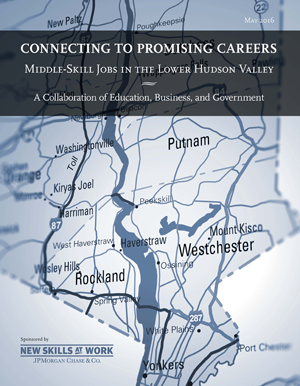Resources and Reports
Middle-Skills jobs in the Lower Hudson Valley
On Tuesday, May 24, 2016, Westchester Community College (WCC) and the New York City Labor Market Information Service at the CUNY Graduate Center (NYCLMIS), along with the Lower Hudson Valley Stakeholders Collaborative, released a report entitled, Connecting to Promising Careers: Middle-Skill Jobs in the Lower Hudson Valley, on promising career opportunities in the Lower Hudson Valley. This report marks the culmination of a collaboration with regional education, business, and government stakeholders who were convened and led by WCC.
The purpose of the study and collaborative effort was to identify areas where educational capacity could be expanded or further strengthened to help Lower Hudson Valley residents connect to well-paying, high-demand, middle-skill jobs and associated careers, and contribute to the economic vitality of the region. The research, conducted by NYCLMIS, highlights the region’s opportunities in Health Information Management, Tech Support, and Hospitality Management.
WCC hosted the launch event and its President, Dr. Belinda Miles, helped to kick off the event, making the case for data-driven approaches to education and workforce strategies. NYCLMIS senior research director, Ronnie Kauder, presented on key elements of the report, including major findings and next steps. Sarah Steinberg, representing JPMorgan Chase, which supported the research, moderated a panel that included bringing together regional representatives from Rockland Community College, the Westchester County Workforce Development Board, White Plains Hospital, and the Hudson Valley Economic Development Corporation. Each panelist enumerated ways the findings and recommendations should be applied to benefit the region’s residents and businesses, and committed to taking at least one action in the short-term.
The event served to focus the region’s efforts to align education to industry demand, coordinate educational programs across the region, form and maintain close industry partnerships, prepare bilingual staff for growing industries in the region, and encourage career-driven workers to continue their education.
Downloads
Full Report and Executive Summary
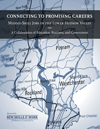 Full Report |
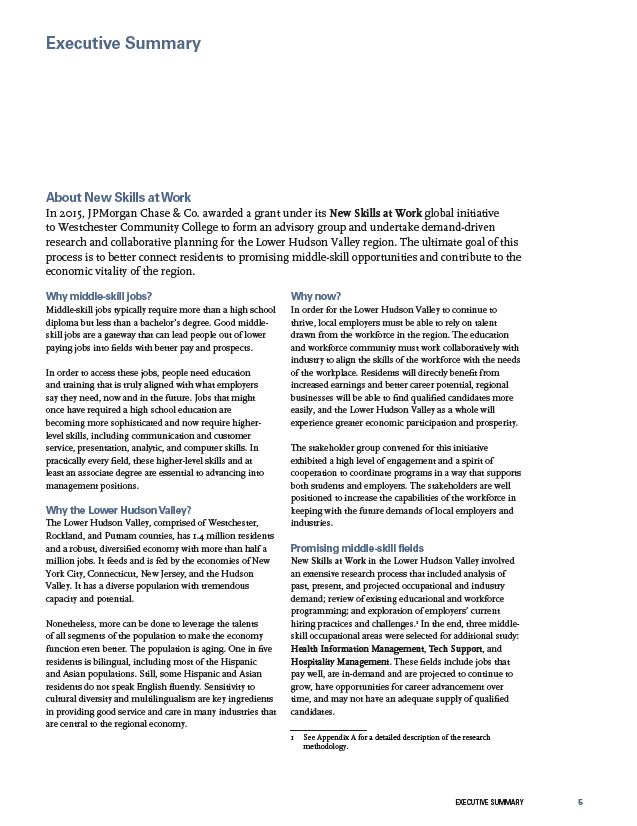 Executive Summary |
Occupational Focus Areas
 Health Information Management Section Health Information Management Section
|
 Tech Support Section Tech Support Section
|
 Hospitality Management Section Hospitality Management Section
|
Introduction
About New Skills at Work
In 2015, JPMorgan Chase & Co. awarded a grant under its New Skills at Work global initiative to Westchester Community College to form an advisory group and, with research support and consultation from the New York City Labor Market Information Service, undertake demand-driven research and collaborative planning for the Lower Hudson Valley region. The ultimate goal of this process is to better connect residents to promising middle-skill opportunities and contribute to the economic vitality of the region.
Why middle-skill jobs?
Middle-skill jobs typically require more than a high school diploma but less than a bachelor’s degree. Good middle-skill jobs are a gateway that can lead people out of lower paying jobs into fields with better pay and employment prospects.
Why the Lower Hudson Valley?
The Lower Hudson Valley, comprised of Westchester, Rockland, and Putnam counties, has 1.4 million residents and a robust, diversified economy with more than half a million jobs, many of which serve their surrounding communities. It feeds and is fed by the economies of New York City, Connecticut, New Jersey, and the Hudson Valley. It has a diverse population with tremendous capacity and potential. Click here for illustrations of key population and economic detail.
Why now?
In order for the Lower Hudson Valley to continue to thrive, local employers must be able to rely on talent drawn from the resident workforce. The education and workforce community must work collaboratively with industry to align the skills of the workforce with the needs of the workplace. Residents will directly benefit from increased earnings and better career potential, regional businesses will be able to find qualified candidates more easily, and the Lower Hudson Valley as a whole will experience greater economic participation and prosperity.
Promising middle-skill fields
This report is the product of an extensive research process, and from this effort, three middle-skill occupational areas were selected for deep exploration: Health Information Management, Tech Support, and Hospitality Management. These fields include jobs that pay well, are in-demand and are projected to continue to grow, have opportunities for career advancement over time, and may not have an adequate supply of qualified candidates. They are also fields that lend themselves to preparation by community colleges and other education and occupational training providers.
Findings and Recommendations
Health Information Management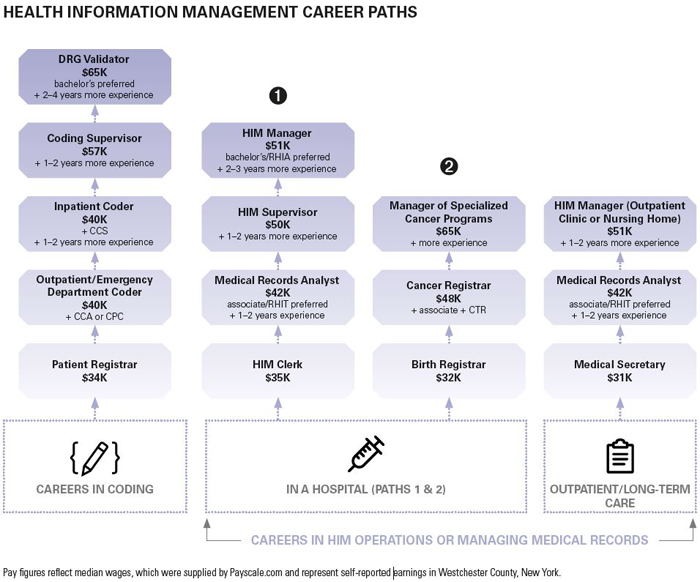
Accounting for nearly one in seven jobs, health care is the largest economic sector in the Lower Hudson Valley. With an aging population and structural changes in health care delivery, this sector is expected to continue growing. As health care providers increasingly rely on electronic health records and related information systems, and as New York State and the federal government expand reporting requirements, demand for health information management personnel is also expected to increase. Sample career pathways are illustrated to the right. View our jobs table for details on these occupations, including education, training and experience requirements.
Many programs in the region can benefit from better alignment to market demand. To help students and job seekers qualify for these jobs, institutions offering medical billing and coding programs, which employers recognize as two distinct functions, should restructure to allow students to specialize in one or the other, offer courses leading to certifications with known value to the industry, and provide opportunities for students to get hands-on experience. Also, the region could benefit from an in-classroom associate degree program accredited by CAHIIM, which would lead to highly marketable credentials. For details, view sections on Opportunities in Health Information Management and Recommendations in the full report.
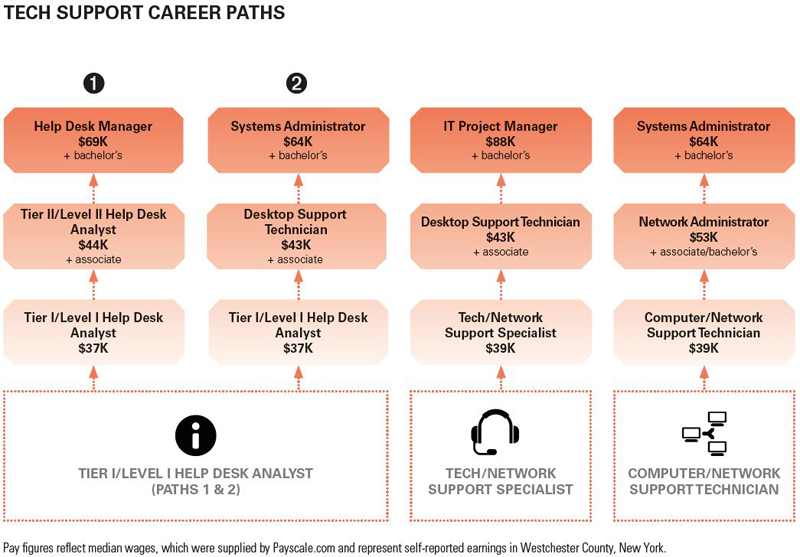 Tech Support
Tech Support
Tech support jobs were selected for attention because they pay well, are projected to increase and typically require a middle-skill level of education. These jobs demand a combination of technical and interpersonal skills that employers are having difficulty finding. Plus, with more education and experience, tech support workers can pursue promising career pathways in several IT areas. Sample career pathways are illustrated to the left. View the jobs table for details on these occupations, including education, training and experience requirements.
To better align skills with demand, we recommend that education and training institutions offer programs that lead to an industry-recognized technical certification, include a hands-on experience component, give students practice troubleshooting hardware and software issues; and incorporate the fundamental principles of computer into entry-level programming courses. Finally, we recommend that schools encourage students in entry-level tech support jobs to continue their education. For details, view sections on Opportunities in Tech Support and Recommendations in the full report.
Hospitality Management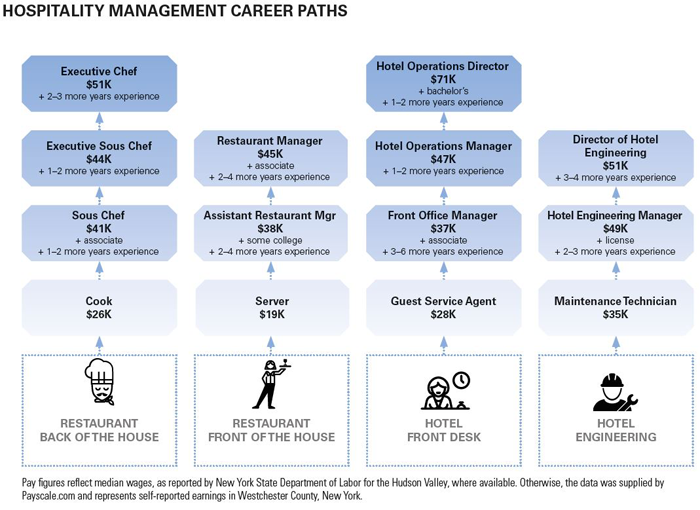
The leisure and hospitality sector is a substantial and growing part of the Lower Hudson Valley economy. Over the last 10 years, this sector grew at a faster rate and added more jobs than any other part of the regional economy. Within the last four years, job growth has been especially robust. Looking forward, this momentum is expected to continue.
People who work in this field provide a range of services to customers and guests. With more education and experience, middle-skill jobs offer pathways into management and other higher-skilled positions. Many hospitality businesses actively invest in their employees and promote from within. Sample career pathways are illustrated to the right. View our jobs table for details on these occupations, including education, training and experience requirements.
To better align skills with demand, we recommend that culinary and management programs broaden their scope to cover the larger hospitality field, integrate the development of customer service and teamwork skills into curricula, create work experience opportunities for students, and identify opportunities with industry to upgrade their workers. For details, view sections on Opportunities in Hospitality Management and Recommendations in the full report.
General Recommendations and Next Steps
There are other promising middle skill fields in the Lower Hudson Valley beyond the three occupational focus areas in this report. A description of these fields, our research into them, and recommendations for better alignment to industry are delineated in Appendix D to the Report.
Finally, common themes emerged from our research that had broader implications beyond the three focus occupational areas. All institutions are encouraged to keep current with industry trends and practices, create or capitalize on existing industry-education partnerships, coordinate with each other to avoid creating overcapacity in the regional labor market while also building capacity in other areas that may be underrepresented, encourage bilingual students to leverage their language skills in the service industries, infuse interpersonal skill development into all offerings across disciplines, and keep students engaged in their studies and encourage those that require more education to continue with it. Finally, to make all of this possible, the stakeholder group should remain active, collaborative, and engaged. For details, view the Recommendations in the full report.
New Skills at Work in the Lower Hudson Valley not only provides a blueprint for strengthening middle-skill opportunities in select occupations, but it also offers a platform for continued collaboration among education, training, and business representatives who have shared interests in strengthening regional employment pipelines.
Acknowledgements
This project was made possible with generous support from
| With leadership by | And research support and consultation from |
 |
 |
Under the general guidance from the following members of Lower Hudson Valley New Skills at Work Stakeholder Collaborative
1199SEIU Training and Upgrading Fund • Business Council of Westchester • Dutchess Community College • Hudson Valley Economic Development Corporation • New York State Department of Labor • Putnam Workforce Partnership • Putnam County Economic Development Corporation • Putnam Northern Westchester BOCES • Rockland BOCES • Rockland Community College • Southern Westchester BOCES • SUNY Westchester Educational Opportunity Center-WCC • Westchester County Association • Westchester County Office of Economic Development • Westchester/Putnam Workforce Development Board • White Plains Education and Training Center • Workforce Development Board of Rockland County • City of Yonkers Office of Workforce Development
Tables and Figures
Figures on Population and Economic Detail
Composition of the Lower Hudson Valley employed population, 2014
Educational attainment for Lower Hudson Valley residents, by race/ethnicity, 2014
Likelihood of employment for Lower Hudson Valley residents, by education level, 2014
Commuting patterns in and out of the Lower Hudson Valley, 2014
Unemployment rates for the Lower Hudson Valley Region, 2005-2015
Share of Lower Hudson Valley jobs by sector, 2014
Growing sectors in the Lower Hudson Valley: 2004 employment and jobs added 2004-2014
Lower Hudson Valley population growth, by race, 2010 to 2014
Top places of birth for the foreign-born population in the Lower Hudson Valley, 2014
Lower Hudson Valley population, by age, 2010 and 2014
English language ability for Lower Hudson Valley residents, by race/ethnicity, 2014
English language ability for Lower Hudson Valley residents, by educational attainment, 2014

